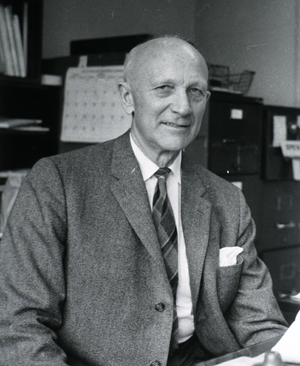Wilder Graves Penfield
Wilder Graves Penfield (January 26, 1891 – April 5, 1976) was a pioneering neurosurgeon and neuroscientist whose groundbreaking work in neurology has had a profound impact on the understanding of the brain. Born in Spokane, Washington, Penfield pursued his education at Princeton University, followed by Oxford University as a Rhodes Scholar, and finally at Johns Hopkins University where he received his medical degree. His contributions to medicine and neuroscience are vast, including the development of the Montreal Procedure, which has significantly advanced the treatment of epilepsy.
Early Life and Education[edit | edit source]
Wilder Penfield was born to a family of modest means. His early education was marked by a keen interest in science and medicine, which led him to pursue a degree in literature at Princeton University, believing that a broad education would serve as a solid foundation for a career in medicine. After Princeton, Penfield was awarded a Rhodes Scholarship to Oxford University, where he studied under Sir Charles Sherrington, a leading figure in neurophysiology. This experience was pivotal, steering Penfield's interests firmly towards neurology. He completed his medical training at Johns Hopkins University, where he was influenced by the work of Harvey Cushing, a pioneer of brain surgery.
Career and Contributions[edit | edit source]
Penfield's professional career is most notably associated with the Montreal Neurological Institute and Hospital (MNI), which he founded in 1934. The MNI became a leading center for neurological research and treatment under his guidance. Penfield's work at the MNI was revolutionary, particularly his development of the Montreal Procedure, a technique that involved stimulating the brain's surface to locate and treat epileptic seizures. This method allowed Penfield to map the functions of various regions of the brain, leading to significant advancements in the understanding of cerebral localization—the idea that specific parts of the brain are responsible for specific functions. One of Penfield's most significant contributions to neuroscience was his detailed mapping of the sensory homunculus and motor homunculus, which illustrate how different parts of the body are represented in the cerebral cortex. His research also delved into the neural basis of memory, and he proposed theories about the role of the temporal lobe in memory and consciousness.
Legacy[edit | edit source]
Wilder Penfield's legacy in neuroscience and neurosurgery is monumental. He was not only a skilled surgeon but also a visionary scientist who significantly advanced our understanding of the brain's structure and function. His work has had lasting impacts on the treatment of neurological disorders, particularly epilepsy. Penfield was honored with numerous awards and recognitions throughout his career, including being made a Companion of the Order of Canada. Penfield's approach to neuroscience was holistic; he believed in treating the patient as a whole and was known for his compassion and dedication to his patients. His writings, including his autobiography "No Man Alone" and "The Mystery of the Mind," have inspired generations of neuroscientists and neurosurgeons.
Selected Publications[edit | edit source]
- The Cerebral Cortex of Man: A Clinical Study of Localization of Function (1950)
- Epilepsy and the Functional Anatomy of the Human Brain (1954)
- The Mystery of the Mind: A Critical Study of Consciousness and the Human Brain (1975)
See Also[edit | edit source]
Search WikiMD
Ad.Tired of being Overweight? Try W8MD's physician weight loss program.
Semaglutide (Ozempic / Wegovy and Tirzepatide (Mounjaro / Zepbound) available.
Advertise on WikiMD
|
WikiMD's Wellness Encyclopedia |
| Let Food Be Thy Medicine Medicine Thy Food - Hippocrates |
Translate this page: - East Asian
中文,
日本,
한국어,
South Asian
हिन्दी,
தமிழ்,
తెలుగు,
Urdu,
ಕನ್ನಡ,
Southeast Asian
Indonesian,
Vietnamese,
Thai,
မြန်မာဘာသာ,
বাংলা
European
español,
Deutsch,
français,
Greek,
português do Brasil,
polski,
română,
русский,
Nederlands,
norsk,
svenska,
suomi,
Italian
Middle Eastern & African
عربى,
Turkish,
Persian,
Hebrew,
Afrikaans,
isiZulu,
Kiswahili,
Other
Bulgarian,
Hungarian,
Czech,
Swedish,
മലയാളം,
मराठी,
ਪੰਜਾਬੀ,
ગુજરાતી,
Portuguese,
Ukrainian
Medical Disclaimer: WikiMD is not a substitute for professional medical advice. The information on WikiMD is provided as an information resource only, may be incorrect, outdated or misleading, and is not to be used or relied on for any diagnostic or treatment purposes. Please consult your health care provider before making any healthcare decisions or for guidance about a specific medical condition. WikiMD expressly disclaims responsibility, and shall have no liability, for any damages, loss, injury, or liability whatsoever suffered as a result of your reliance on the information contained in this site. By visiting this site you agree to the foregoing terms and conditions, which may from time to time be changed or supplemented by WikiMD. If you do not agree to the foregoing terms and conditions, you should not enter or use this site. See full disclaimer.
Credits:Most images are courtesy of Wikimedia commons, and templates Wikipedia, licensed under CC BY SA or similar.
Contributors: Prab R. Tumpati, MD

